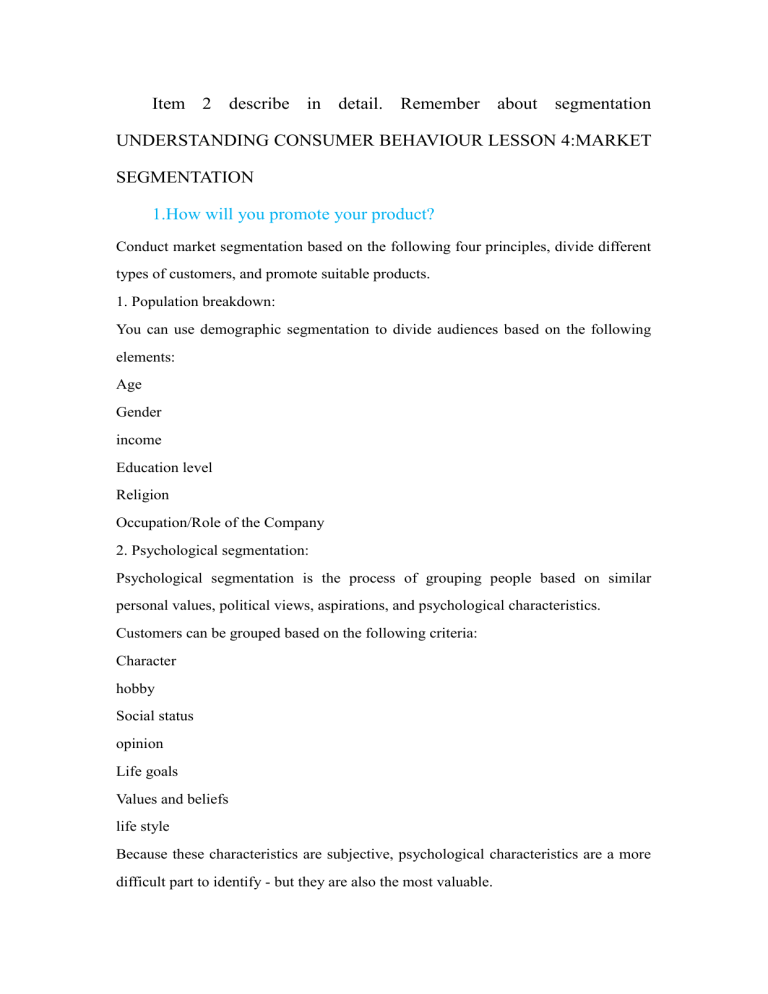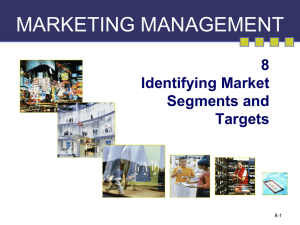
Item 2 describe in detail. Remember about segmentation UNDERSTANDING CONSUMER BEHAVIOUR LESSON 4:MARKET SEGMENTATION 1.How will you promote your product? Conduct market segmentation based on the following four principles, divide different types of customers, and promote suitable products. 1. Population breakdown: You can use demographic segmentation to divide audiences based on the following elements: Age Gender income Education level Religion Occupation/Role of the Company 2. Psychological segmentation: Psychological segmentation is the process of grouping people based on similar personal values, political views, aspirations, and psychological characteristics. Customers can be grouped based on the following criteria: Character hobby Social status opinion Life goals Values and beliefs life style Because these characteristics are subjective, psychological characteristics are a more difficult part to identify - but they are also the most valuable. The best place to collect data for a psychological segment is through customer analysis tools and social media. Surveys, interviews, and focus groups should also be used to enhance customer understanding of the segment. Through psychological segmentation, I can deeply understand customers' preferences, dislikes, needs, wants, and likes. You can then create marketing campaigns that resonate with their psychological characteristics. 3. Geographic segmentation: Geographic segmentation is the process of grouping customers based on their place of residence and shopping. People living in the same city, state, or postal code often have similar needs, attitudes, and cultural preferences. The real advantage of geographic segmentation is that it provides insight into the customer's location and perception of many geographic specific variables: Climate Culture Language Population density - (urban and rural) 4. Behavior segmentation: Behavior segmentation is the process of grouping customers based on their common behaviors when interacting with the brand. For this type of segmentation, audiences can be grouped according to the following groups: Consumption habits Buying habits Browsing habits Interact with your brand Loyalty to your brand Product feedback The website can analyze and collect these objective data, identify patterns of customer behavior, and help predict how customers will interact with the brand in the future. 2.How to advertise? 1. Conduct audience and market research To view my existing customers: 1.1 Obtain as much information as possible from current customers and try to hone some of these features in different types of market segments. If you are having trouble getting information from your customer base, you can also try a short post purchase survey. 1.2 View Competitors: If you have identified your main competitors, see if you can name their strategy. Can you name who they are trying to communicate with or target? If possible, it is likely to also target this audience group. Using public resources: 1.3 Public resources (such as information from trade fairs, annual reports, chambers of commerce, and the Bureau of Labor Statistics) can be a great help in obtaining a general understanding of your industry or the demographic information to which your clients belong. 2. Analyze data and find market segments 2.1 Complete market research and start mining valuable data. 2.2 View the characteristics of all different types of market segments, such as age, values, interests, location, and purchasing behavior. 2.3 Remember these different market segments and populations. Note whether there are multiple different groups in the audience and see if you can find ways to connect different users. 3. Develop different types of advertising based on different audiences, and test whether the advertising strategy is changed as needed 3.How do people find out about your store and your products? (remember your segment) 1. Leverage (and continuously build) my email list. Even in physical stores, it is important to have a strong email marketing strategy. Collect as many email addresses as possible - customers, prospects, people interested in my activities, etc. Once started, I will be able to send emails to all these people to let them know that they can access my store 2. Improve your sense of organic social presence. For my store and products, I hope to seize every opportunity to improve my digital engagement. One of the simplest and most effective ways is to take care of my social media channels and ensure that they have vibrant images and engaging videos. 3. Establish an online store website. Periodically push content about stores and products online, including promotions, new content, product launches, and other news that encourages customers to visit my online store. 4. Create interesting and useful content. Creating exciting content for people who want to buy your product is a good way to bring traffic to my online store and make people remember my product. 5. Try Google Advertising. Search engine marketing is a good way to promote stores and products because it does not require any design and can be very effective in driving new traffic. I can also obtain real-time results and adjust your advertising series strategy based on the results at any time. 6. Advertising on social platforms. Social media is a good place to focus advertising spending because you know people spend time on social platforms. Open Questions True/False Question Mini Case What is behavioral economics? Behavioral Economics (BE) is a field of economics that emphasizes the importance of how individuals behave in certain context. In particular, this approach takes into account the results from other disciplines, like Psychology, Sociology, and Computer Science, to improve the analysis of agents' choices. Standart model I didn't find the information of Standart model. The Standard Model of Particle Physics is a theory that describes three of the four known fundamental forces in the universe (electromagnetic force, weak interaction, and strong interaction - excluding gravity) and classifies all known elementary particles. consumer behaviour Consumer behavior is the study of individuals, groups, or organizations, as well as all activities related to the purchase, use, and disposal of goods and services. Consumer behavior includes how consumers' emotions, attitudes, and preferences affect purchasing behavior. What is lifestyle marketing? Lifestyle marketing is a type of marketing that focuses on creating a connection between a product or service and the consumer’s lifestyle. It aims to create a sense of connection between the consumer and the product by emphasizing the lifestyle that the product or service can help to create or improve. Explain VALS segmentation. VALS ("Values and Lifestyles") is a proprietary research methodology used for psychographic market segmentation. Market segmentation is designed to guide companies in tailoring their products and services in order to appeal to the people most likely to purchase them. VALS Segmentation Model divides people into eight categories: survivors, makers, strivers, believers, experiencers, achievers, thinkers, and innovators. Differentiate and explain concentrated marketing, differentiated marketing and counter segmentation. Advantages of concentrated marketing strategy: 1. Due to the small number of market segments, small businesses can adopt this strategy to better serve the market segments. 2. It reduces subsequent production, operation and management costs. 3.It enables organizations to maximize the use of their available resources and maximize profits from these resources. Disadvantages of of concentrated marketing strategy: 1. This strategy is very risky to implement, because if the wrong market segment is selected as the target market, the survival of the organization will become difficult. 2. This strategy has increased market competition.By seeing an organization's profits in a particular market segment, more and more organizations are joining that market segment, thereby intensifying competition. Advantages of differentiated marketing strategy: 1. It attracts maximum number of customers by providing different products to different customers according to their needs and wants. 2. Increase in the number of customers results in increase in the sales and thereby the profit of the organization. 3. It enables proper and best utilization of the available resources of organization. Disadvantages of of differentiated marketing strategy: 1. The organization has to produce different product according to different needs and wants of different segment of the market. 2. It increases the cost of marketing research, product planning, product development, physical distribution, promotion and administration. 3. This strategy is only useful for the organizations producing on large scale and is useful in long run. Advantages of counter segmentation strategy: 1.Market aggregation enables companies to produce on a large scale.Large-scale production provides organizations with a variety of external and internal economies. 2.Enable the organization to adopt the theory of standardization, specialization, and division of labor. 3.There is no need to formulate different marketing plans and policies for different market segments. 4.Enable the organization to maximize the use of its resources. Disadvantages of counter segmentation strategy: 1.The strategy is not consumer-oriented, but only focuses on producers and their products. 2.The effectiveness of this strategy in the modern consumer-oriented market is very limited, because all consumers can never have the same taste and attitude. 3.This strategy can only be useful and successful in the short term.Cannot be used for a long time. The individual determinants of consumer behaviour. Psychological (personal preferences and predispositions, needs, personal influence, personal perception, etc.) Demographic (age, sex, income, profession, income, etc.) The cultural determinants of consumer behaviour the decision-making process Motivation Emotion. A person's culture has a tremendous impact on their thinking process and behavior. Because it has such a significant impact on how people view the world around them, their position in it, and how they make decisions, it often plays a role in determining the ways and reasons we consume goods and services.





